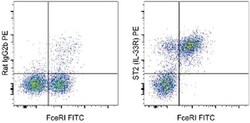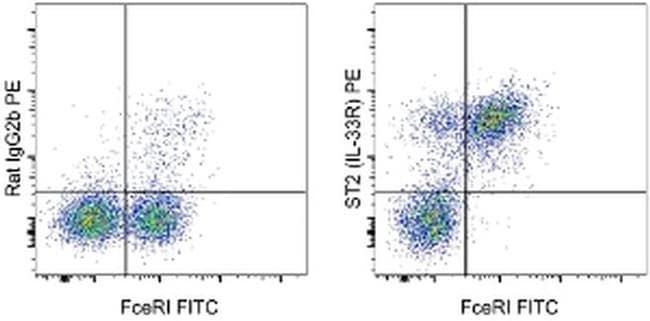Learn More
Invitrogen™ IL-33R (ST2) Monoclonal Antibody (RMST2-33), PE, eBioscience™, Invitrogen™
Rat Monoclonal Antibody
Brand: Invitrogen™ 12-9333-82
Description
Description: The RMST2-33 monoclonal antibody reacts with mouse ST2, also known as IL-33R or interleukin 1 receptor-like 1. ST2 is a member of the IL-1 receptor family. In the membrane-bound form, it consists of three extracellular immunoglobulin domains and an intracellular toll-interleukin-1 receptor domain. ST2 forms a dimer with IL-1R accessory protein in a ligand-dependent manner. IL-33/ST2 interaction induces the production of TH2 cytokines. ST2 also has a soluble isoform lacking transmembrane and intracellular toll-interleukin-1 receptor domains. It is believed that the soluble form functions as a decoy receptor that can block membrane bound IL-33/ST2 interaction. ST2 is expressed by TH2 lymphocytes, mast cells, eosinophils, basophils, innate lymphocytes, smooth muscle cells, and endothelial cells and is involved in host defense, allergy, and inflammation. IL-33/ST2 interaction has also been shown to be atheroprotective. RMST2-33 has been reported to bind and activate ST2 in in vitro assays. Applications Reported: This RMST2-33 antibody has been reported for use in flow cytometric analysis. Applications Tested: This RMST2-33 antibody has been tested by flow cytometric analysis of mouse bone marrow-derived mast cells. Excitation: 488-561 nm; Emission: 578 nm; Laser: Blue Laser, Green Laser, Yellow-Green Laser. Filtration: 0.2 μm post-manufacturing filtered.
IL-33R, also known as ST2, is a receptor for IL-33. It is a member of the IL-1 receptor family of innate receptors. Its extracellular domain consists of 3 Ig-like domains that directly interact with its co-receptor IL-1RAcP, and the ligand alarmin, IL-33. IL-33 ligation results in the association of IL-33R complex with its adaptor proteins MyD88, IRAK1, IRAK4 and TRAF6, and activation of the NF-kB, and MAPK pathways. This, in turn, instigates the release of chemokines and cytokines such as IL-5, IL-6, IL-8, and IL-13. Two most common isoforms of IL-33R that result from alternative splicing are ST2L - the membrane bound form, and ST2S - the soluble form. The membrane bound form can be released from the cell surface by proteolytic cleavage. The soluble forms have been suggested to act as decoys dampening the IL-33 signaling. IL-33R is primarily expressed by mast cells, basophils, and eosinophils. In mouse, IL-33R expression has been shown on ILC2 and Th2 cells. IL-33R signaling has been implicated in the number of immune conditions, including allergies, arthritis, atherosclerosis and sepsis.
Specifications
| IL-33R (ST2) | |
| Monoclonal | |
| 0.2 mg/mL | |
| PBS with 0.09% sodium azide; pH 7.2 | |
| P14719 | |
| IL1RL1 | |
| Affinity chromatography | |
| RUO | |
| 17082 | |
| 4°C, store in dark, DO NOT FREEZE! | |
| Liquid |
| Flow Cytometry | |
| RMST2-33 | |
| PE | |
| IL1RL1 | |
| DER4; Fit1; Fit-1; Fos-responsive gene 1 protein; growth stimulation-expressed; homolog of mouse growth stimulation-expressed; IL-1 R4; IL1RL1; IL-1RL1; IL33R; IL-33R; interleukin 1 receptor like 1; interleukin 1 receptor-like 1; interleukin 1 receptor-related protein; Interleukin1 receptor like 1; interleukin-1 receptor-like 1; Interleukin-33 receptor alpha chain; Ly84; lymphocyte antigen 84; Protein ST2; Protein T1; sIL 33R; soluble IL 33 Receptor; soluble IL 33R; St2; ST2L; St2-rs1; ST2V; Ste2; T1; T1/ST2 | |
| Rat | |
| 100 μg | |
| Primary | |
| Mouse | |
| Antibody | |
| IgG2b κ |
Your input is important to us. Please complete this form to provide feedback related to the content on this product.
For Research Use Only.





